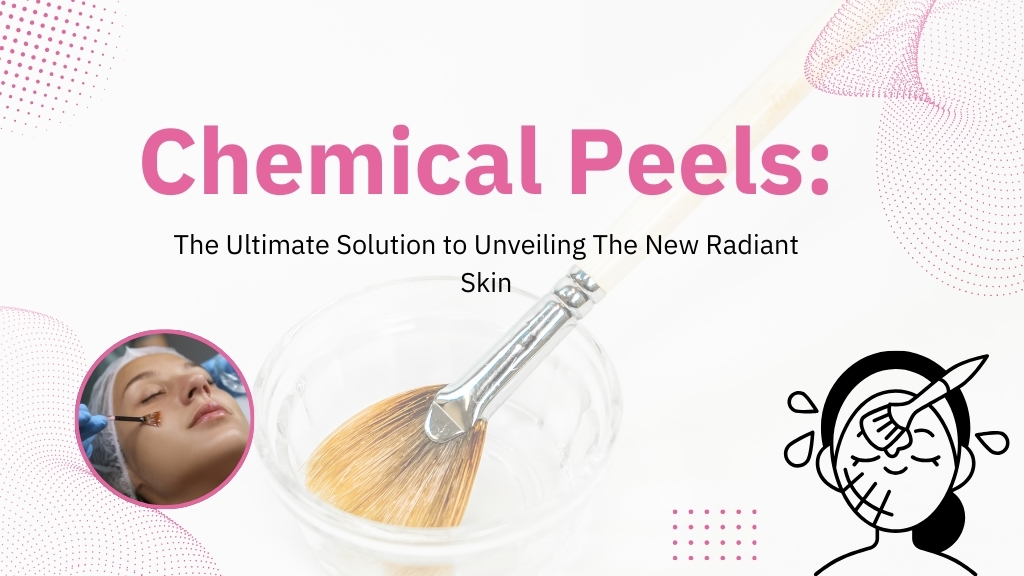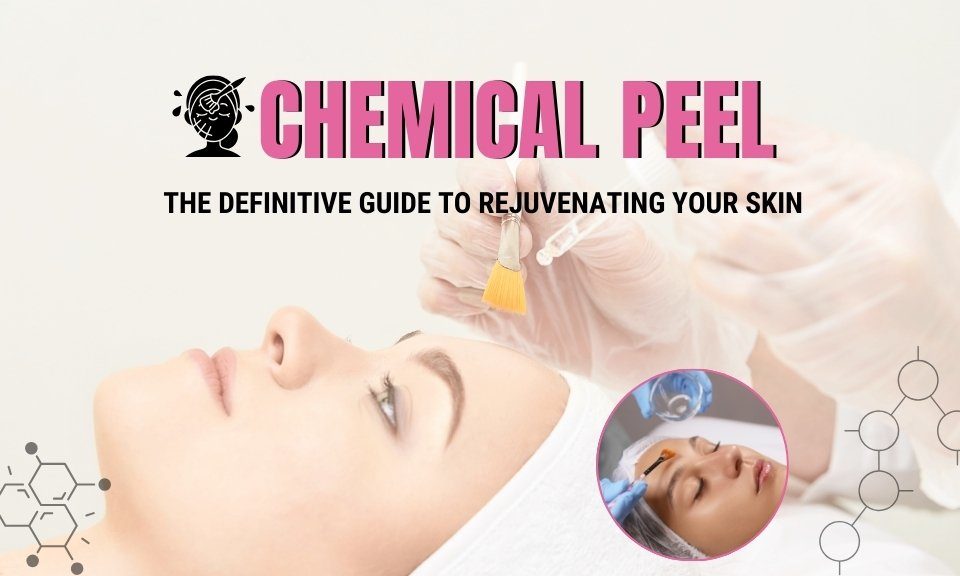- Feel Free To Call Us: +91 9311691081
- +91 9999189391
- +91 9540318080
- contact@dermalyn.in
Chemical Peels: The Ultimate Solution to Unveiling The New Radiant Skin

The Botox Treatment: Hair Botox Treatment, the Ultimate Quick Fix to Give Life to Your Hair
September 18, 2024
Enhancing Beauty: The Art of Lip Micropigmentation
September 24, 2024Chemical Peels Treatment have really transformed the world of skincare by acting as a painless way of addressing myriad skin problems. From hyperpigmentation to fine lines and wrinkles, peeling has become so common for all those who seek perfect, blemish-free skin. In this detailed guide, we look at the benefits of peeling, the types, and just what to expect from the treatment process.
Understanding Chemical Peels Treatment
Chemical peels are a skin rejuvenation procedure that involves the application of a chemical solution on the skin. This solution is, therefore, used to eliminate the top layer of dead skin cells that would otherwise make the skin look worn out, showing the healthy, more youthful-appearing layer of skin underneath. Each may be formulated for specific skin concerns, so Chemical Peels for Hyperpigmentation are versatile in their treatment options for various skin types and conditions. They are particularly effective in the treatment of conditions such as acne scars, age spots, discoloration, fine lines and wrinkles, melasma, and even rosacea.
The chemical solutions applied in such treatments are usually sourced from natural sources, which include fruits and plants. The commonly applied acids include glycolic acid, salicylic acid, lactic acid, and trichloroacetic acid, popularly known as TCA. These acids exfoliate the skin, increase cell turnover, and stimulate the production of collagen, thereby improving skin texture and tone.
Chemical Peel Types
There are many types of Chemical Peels, each in its formulation and depth of penetration. Three major classifications for chemical peels include the following :
- Superficial peels – These peels use very mild acids, normally AHAs or BHAs, which gently exfoliate the skin surface. Varieties of these include:
- Glycolic Peel: With a minor molecular size, glycolic acid works profoundly in the treatment of exfoliation and restoring a healthy glow. This is very effective for fine lines and uneven skin tone.
- Lactic Acid Peel: This peel is made from milk and hence is absolutely tender. It is ideal for sensitive skin. It moisturizes while exfoliating and hence recommended for dry skins.
- Jessner’s Peel: Comprising lactic acid, salicylic acid, and resorcinol in its combination, this peel will be effective in improving sun damage and hyperpigmentation. It can even reduce oil production, therefore making it beneficial for acne-prone skin.
2. Medium Peels: These peels involve deeper penetration into the skin through TCA, which is utilized to correct medium-depth wrinkles, acne scars, and hyperpigmentation. Medium peels can offer more marked improvements in skin texture and skin tone and hence are popular among individuals for whom such concerns have become more pronounced.
3. Deep Peels: These go deepest into the skin, with phenol being one example. This is utilized to deal with serious sun damage, precancerous growths, and deep wrinkles. This variety of peel will take longer to recover from but does offer the most dramatic results for those who have more serious problems with their skin.
Chemical Peels Benefits
Chemical peels are associated with a plethora of benefits towards the skin, including:
- Smoothening of Skin Texture and Tone: Chemical peels even out the tone of the skin and impart an overall better texture, which is much smoother and brighter.
- Fine Lines and Wrinkles Become Less Visible: The manufacture of collagen leads to the diminishment of fine lines and wrinkles, giving a fresher, more youthful look.
- Stricter Pores: Chemical peels could be performed in a manner that large pores get blocked and, hence, reduced, therefore leaving clearer skin.
- Decreased Hyper-Pigmentation: Types of hyperpigmentation, such as age spots, sun damage, and melasma, can be treated with the use of chemical peels. They are, for that matter, very excellent in performing the job for anyone looking for even skin tone.
- Researchers have indicated that improvement in active acne and its scarring is an added advantage of chemical peels, making them popular among subjects with acne-prone skin.
The Chemical Peel Procedure
The procedure for a Chemical Peel generally involves the following key steps:
- Consultation: The treatment should be preceded by a consultation with a qualified dermatologist. During this session, the dermatologist will assess skin type and address concerns, advising on the most suitable type of chemical peel.
- Preparation: The skin will be cleaned on the day of the procedure to remove makeup, oil, or impurities, which might interfere with the proper penetration of the chemical solution.
- Application of the Chemical Solution: The solution chosen is applied to the skin using a brush, cotton pad, or spray. In procedures based on the type of peel, the solution could be left on for some time. During this stage, you may feel a slight stinging or burning sensation, which is normal.
- Neutralization: Certain peels will have a neutralizing solution on the skin to stop the action of the peel. Most medium and deep peels will include this step.
- Aftercare: Immediately post-treatment, the skin will be red and swollen, sunburn-like. Your dermatologist will give you instructions on aftercare, possibly including no sun exposure, only gentle cleansers, and moisturizers.
- Healing and Recovery: Depending on the depth of peel, the recovery time might also change. Most superficial peels would not require more rest than a couple of hours while medium and deep peels take several days peeling and redness.
- Follow-Up: A follow-up may be scheduled to check the healing process and whether more treatments are required.
Factors Affecting the Chemical Peeling Cost
The Cost of Chemical Peeling would depend on the following:
Type of Peel: Deep peels are more expensive compared to superficial or medium peels. For example, a TCA peel can be more expensive than a glycolic peel since one is deeper and more ‘intense’ in its treatment.
- Geographical Location: It may be more costly in prominent cities, with consideration taken into account like the cost of living and the location of the clinic in itself. It can be said that clinics within an urban area charge more for their services.
- Post-Peel Care: Additional treatment services like follow-up care and evaluation may be factored into the overall cost. Also, if the skin condition you’re trying to get rid of requires continuing treatment, this too will add to the overall cost.
- Frequency: If multiple sessions will be required in order to achieve desired results, the total cost will be higher. Many patients benefit from a series of peels in order to maximize their results.
- Area of Treatment: Larger areas of the body are to be treated, like the face, neck, and hands, than smaller areas of the body.
Conclusion
Chemical Peels for Hyperpigmentation safely help one achieve radiant skin. From treating hyperpigmentation to ironing out fine lines and wrinkles, or simply improving the skin’s texture, Chemical Peeling Treatment is there to help. Along with a qualified dermatologist, you will be able to create a personalized treatment plan that takes your skin into consideration and helps you achieve the results you desire.
The results of Chemical Peels for Hyperpigmentation could last longer to improve the appearance of your skin, provided good care and maintenance are taken. It’s a great investment in your skincare journey. If you do a search for “Chemical Peel Near Me,” consider consulting with a board-certified dermatologist to explore your options that best meet your individual skin types and concerns.




